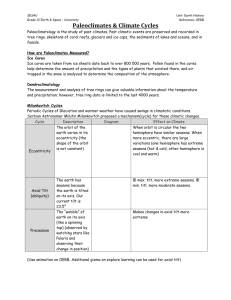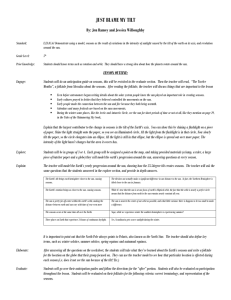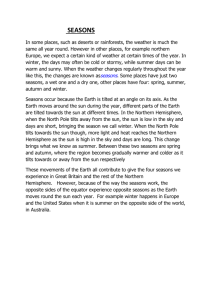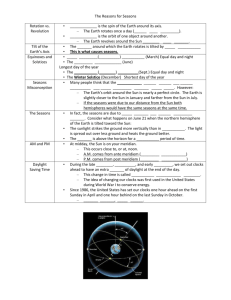Task - Science - Grade 4 - Seasons
advertisement
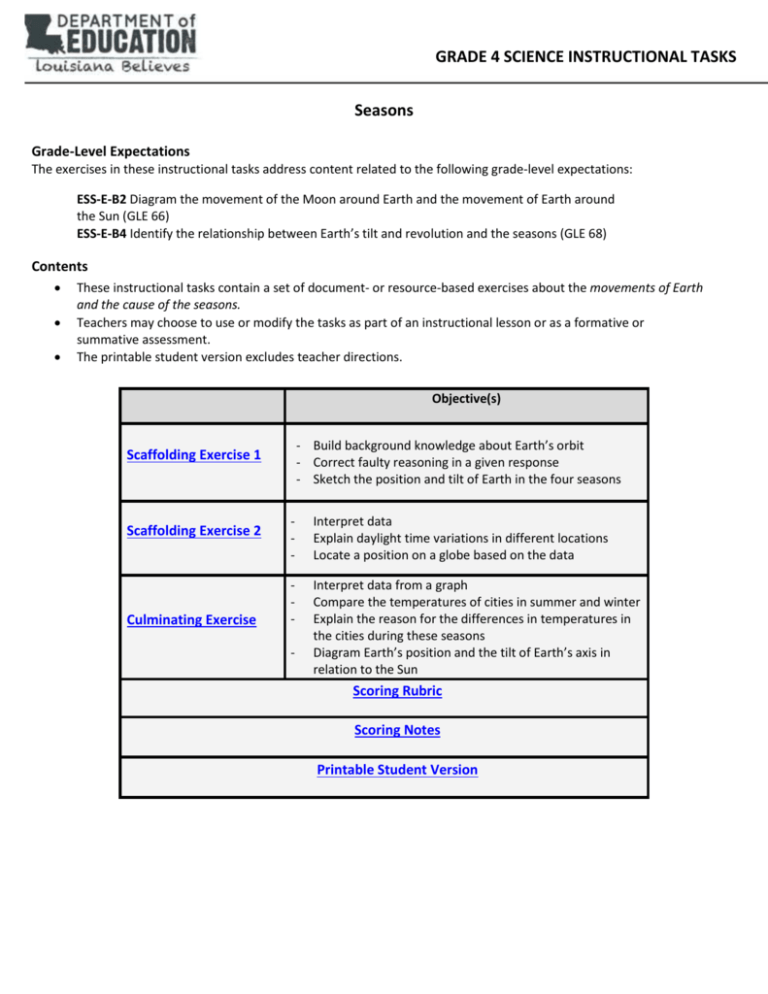
GRADE 4 SCIENCE INSTRUCTIONAL TASKS Seasons Grade-Level Expectations The exercises in these instructional tasks address content related to the following grade-level expectations: ESS-E-B2 Diagram the movement of the Moon around Earth and the movement of Earth around the Sun (GLE 66) ESS-E-B4 Identify the relationship between Earth’s tilt and revolution and the seasons (GLE 68) Contents These instructional tasks contain a set of document- or resource-based exercises about the movements of Earth and the cause of the seasons. Teachers may choose to use or modify the tasks as part of an instructional lesson or as a formative or summative assessment. The printable student version excludes teacher directions. Objective(s) - Build background knowledge about Earth’s orbit - Correct faulty reasoning in a given response - Sketch the position and tilt of Earth in the four seasons Scaffolding Exercise 1 Scaffolding Exercise 2 Culminating Exercise - Interpret data Explain daylight time variations in different locations Locate a position on a globe based on the data - Interpret data from a graph Compare the temperatures of cities in summer and winter Explain the reason for the differences in temperatures in the cities during these seasons Diagram Earth’s position and the tilt of Earth’s axis in relation to the Sun - Scoring Rubric Scoring Notes Printable Student Version Teacher Directions: Show the video of Earth’s tilt and rotation at http://www.teachertube.com/video/what-causes-seasons-on-earth-657 and then view the image at http://media-1.web.britannica.com/eb-media/20/151220-004-CA06CC8A.jpg to examine the shape of Earth’s orbit and its location in the winter and summer. Ask students respond to the following prompt. Scaffolding Exercise 1 John was asked to explain why Earth has seasons. He drew the diagram and wrote the explanation below. John’s Explanation: Earth has seasons because of the shape of its orbit. It is closer to the sun in the summer and farther away from the sun in the winter. Correct John’s faulty reasoning. Write a corrected explanation and draw a diagram showing Earth during each of the four seasons to help John understand the actual shape of Earth’s orbit around the sun and the correct reason for the seasons. Scaffolding Exercise 2 Teacher Directions: Have students analyze the data to respond to the prompts below. Date: June 21, 2013 Sunrise Sunset City Latitude Day Length Stockholm 59.3 °N 3:31 AM 10:08 PM 18hr 37min Moscow 55.8 °N 4:45 AM 10:18 PM 17hr 33min Washington, DC 38.9 °N 5:43 AM 8:37 PM 14hr 54min Singapore 1.3 °N 7:00 AM 7:12 PM 12hr 12min Sydney 33.9 °S 7:00 AM 4:54 PM 9hr 54min Cape Town 33.9 °S 7:51 AM 5:45 PM 9hr 54min Source: http://www.washingtonpost.com/blogs/capital-weather-gang/wp/2013/06/20/summer-solstice-2013-northern-hemispheres-longest-day-highest-sun-of-the-year Analyze the latitude and length of days for the cities of Moscow, Russia, and Sydney, Australia. 1. Explain why the data for these two cities is different. 2. Singapore’s day length was 12 hours, 12 minutes on June 21, 2013. Without looking at another map, determine whether Singapore is geographically at Location 1, 2, 3, or 4 on the globe. Provide an explanation for your reasoning based on the data provided and the tilt of the Earth. 1 3 2 4 Teacher Directions: Have students analyze the graph to respond to the prompts below. Average Temperatures by Month (°C) 35 30 25 20 Rio de Janeiro, Brazil New York, New York 15 Sydney, Australia Culminating Exercise 10 5 New Orleans, Louisiana 0 The graph above shows average high temperatures throughout the year for four different cities. Two of the cities are in the northern hemisphere and two of the cities are in the southern hemisphere. A. B. C. D. Using the data in the graph, compare the seasonal patterns in each city. Cite evidence from the graph to support your comparisons. Explain what causes these differences. Sketch a diagram (without continents) of Earth’s axis, tilt, and position in relation to the Sun for the month of January in Sydney, Australia and in New York, New York. Rubric Key Elements: A. B. C. D. Response correctly compares the seasons of summer and winter in the cities. Response cites evidence from the graph to support comparisons. Response correctly explains what causes the differences in seasons. Response correctly diagrams Earth’s position in relation to the sun for Sydney, Australia, and New York, New York. Response includes all four key elements. 4 Points Response contains no scientific errors. Response includes three of the four key elements. 3 Points Response may include scientific errors. Response includes two of the four key elements. 2 Points Response may include scientific errors. Response includes one of the four key elements. 1 Point Response may include scientific errors. A well-developed response should demonstrate a correct and thorough understanding of the movement of the earth and the relationship between the tilt of the earth and seasons. The response should be clear, include specific details, show a higher level of reasoning skills where appropriate, and address the key elements of the task. Scoring Notes Student responses will not be an exact imitation of the responses below. These are given only as examples. A. The response indicates that while the cities in the northern hemisphere are experiencing summer in June, July and August, it is winter in the southern hemisphere. Some of the cities experience a great variety of temperature change in the seasons than others. B. The temperatures in New Orleans and New York are higher in June, July, and August. New Orleans reaches over 30°C and New York reaches almost 30°C. In the winter months of December, January, and February, New Orleans and New York experience colder temperatures, with New Orleans dropping below 20°C and New York dropping below 5°C. In comparison, Rio de Janeiro experiences much milder temperature changes. The temperature tends to stay between 25°C and 32°C all year, according to the graph. Sydney Australia has more extreme temperature changes than Rio de Janeiro but not as wide of differences as New York and New Orleans. The temperature varies between 27°C and 18°C. In addition, the colder months in Rio de Janeiro and Sydney are during June, July, and August while these are the hottest months in New Orleans and New York. C. The causes for the differences in temperatures and seasons are both the angle and direction of the tilt of Earth’s axis and Earth’s position in relation to the sun as it revolves around the sun. The areas experiencing the most direct sunlight are the warmest. D. The diagram should indicate the correct position of the Earth in relation to the Sun. Illustrate the tilt of the earth at an angle of approximately 23.5 degrees with the correct direction of Earth’s axis tilt. Earth’s Axis New York SUN Sydney Equator Additional Resources for Teachers: https://www.youtube.com/watch?v=9n04SEzuvXo http://media-1.web.britannica.com/eb-media/20/151220-004-CA06CC8A.jpg http://education.nationalgeographic.com/education/activity/the-reason-for-the-seasons/?ar_a=1 http://web.nmsu.edu/~esgerken/lecture07/slide05.html http://www.uen.org/Lessonplan/preview.cgi?LPid=2499 http://www.universetoday.com/61202/earths-orbit-around-the-sun/ http://www.washingtonpost.com/blogs/capital-weather-gang/wp/2013/06/20/summer-solstice-2013-northern-hemispheres-longest-dayhighest-sun-of-the-year https://allthingsgeography1.wordpress.com/2012/12/13/weather-and-climate-lesson-2 Printable Student Version John was asked to explain why Earth has seasons. He wrote the explanation and drew the diagram below. John’s Explanation: Earth has seasons because of the shape of its orbit. It is closer to the sun in the summer and farther away from the sun in the winter. Correct John’s faulty reasoning. Write a corrected explanation and draw a diagram showing Earth during each of the four seasons to help John understand the actual shape of Earth’s orbit around the sun and the correct reason for the seasons. Analyze the data to respond to the prompts below. Date: June 21, 2013 Sunrise Sunset City Latitude Day Length Stockholm 59.3 °N 3:31 AM 10:08 PM 18hr 37min Moscow 55.8 °N 4:45 AM 10:18 PM 17hr 33min Washington, DC 38.9 °N 5:43 AM 8:37 PM 14hr 54min Singapore 1.3 °N 7:00 AM 7:12 PM 12hr 12min Sydney 33.9 °S 7:00 AM 4:54 PM 9hr 54min Cape Town 33.9 °S 7:51 AM 5:45 PM 9hr 54min Source: http://www.washingtonpost.com/blogs/capital-weather-gang/wp/2013/06/20/summer-solstice-2013-northern-hemispheres-longest-day-highest-sun-of-the-year Analyze the latitude and length of days for the cities of Moscow, Russia, and Sydney, Australia. 1. Explain why the data for these two cities is different. 2. Singapore’s day length was 12 hours, 12 minutes on June 21, 2013. Without looking at another map, determine whether Singapore is geographically at Location 1, 2, 3, or 4 on the globe. Provide an explanation for your reasoning based on the data provided and the tilt of the Earth. 1 3 2 4 Analyze the data in the graph below to respond to the prompts below. Average Temperatures by Month (°C) 35 30 25 20 Rio de Janeiro, Brazil New York, New York 15 Sydney, Australia 10 5 New Orleans, Louisiana 0 The graph above shows average high temperatures throughout the year for four different cities. Two of the cities are in the northern hemisphere and two of the cities are in the southern hemisphere. A. B. C. D. Using the data in the graph, compare the seasonal patterns in each city. Cite evidence from the graph to support your comparisons. Explain what causes these differences. Sketch a diagram (without continents) of Earth’s axis, tilt, and position in relation to the Sun for the month of January in Sydney, Australia and in New York, New York.

